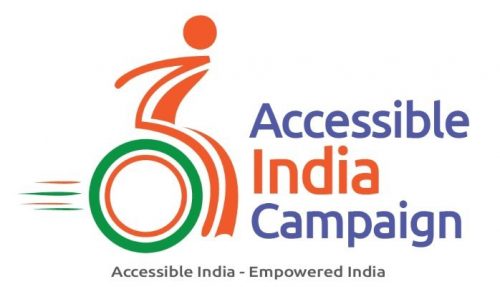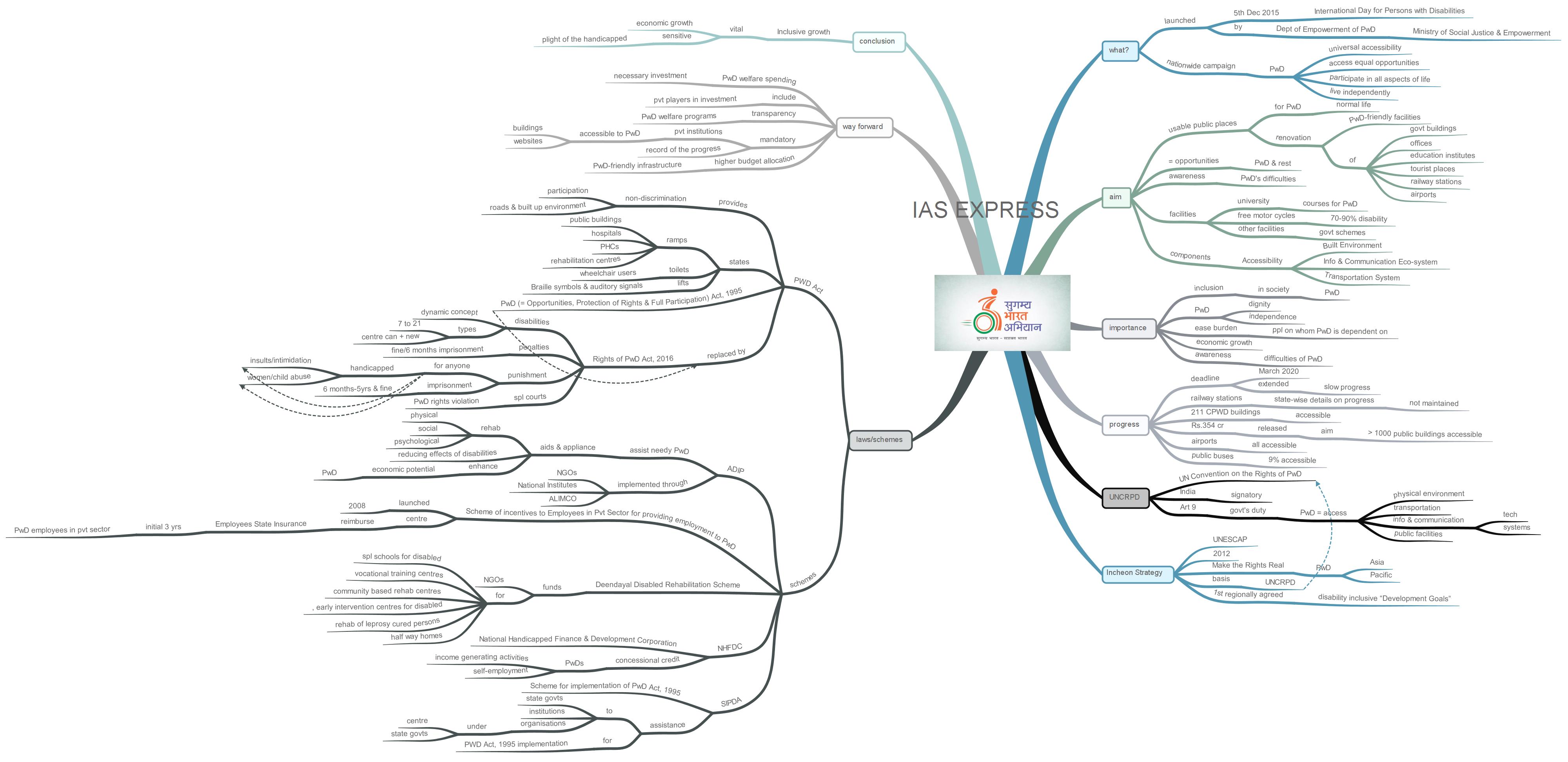Sugamya Bharat Abhiyan (Accessible India Campaign)

From Current Affairs Notes for UPSC » Editorials & In-depths » This topic
IAS EXPRESS Vs UPSC Prelims 2024: 85+ questions reflected
On December 13, 2019, the Ministry of Social Justice and Empowerment had announced its intention to extend the deadline of the Accessible India Campaign to March 2020 due to its slow progress. The Central Advisory Board (CAB) chaired by social justice and empowerment minister took this decision. Failure to provide for the accessibility to persons with disability is showing the government’s negligence to provide for the inclusive growth and equal opportunity to all of the Indian citizens.
What is an Accessible India Campaign?
- Accessible India Campaign or Sugamya Bharat Abhiyan was launched on 5th December of 2015 (International Day for Persons with Disabilities).
- It is a Union government’s campaign to make India more friendly and accessible to the differently-abled persons.
- The Department of Empowerment of Persons with Disability (DEPwD) under the Ministry of Social Justice and Empowerment conceptualised the campaign as a nation-wide flagship campaign for achieving universal accessibility to enable persons with disabilities (PwD) to gain access for equal opportunities, live independently and participate fully in all aspects of life in an inclusive society.
- The campaign aims to enhance the accessibility of built environment, transport system and Information and communication eco-system.
What are the objectives of Accessible India Campaign?
- Sugamya Bharat Abhiyan has numerous objectives that need to be fulfilled by the government to ensure the inclusive growth of the differently-abled persons.
- Usable Public places for PwD: First, it aims to make all public places in the country usable and accessible for differently-abled persons so that they lead a normal life like the rest of the population. Through this initiative, all the government buildings, education institutes, offices, tourist places, railway stations, airports etc. will be renovated to include the necessary facilities for the differently-abled persons.
- Equal opportunity: This campaign aims to make India universally accessible so that the PwD have opportunities irrespective of their physical and mental disability.
- Awareness: This campaign aims to spread awareness about the difficulties faced by the PwD to society so that people are conscious of the problems faced by those who are handicapped.
- Facilities: It also proposes the establishment of a university that conducts courses for these people. Additionally, it promises to provide people with 70-90% disability a free motorised motorcycle for easier mobility. Other affordable facilities are provided to these people under various government schemes.
- The three components of this campaign are:
- Built Environment Accessibility
- Transportation System accessibility
- Information and Communication Eco-system Accessibility
Why do we need Sugamya Bharat Abhiyan?
- This campaign will make the persons with disabilities feel that they are included and are not different from the rest of the population.
- This advocate for the value of equality for all.
- It will ensure that the differently-abled persons are living the lives of dignity and independence.
- This will ease the burden on those people on whom the persons with disabilities are dependent on.
- It will increase the contribution of the differently-abled persons in India’s economic growth and development.
- It will also spread awareness about the issues faced by these people, leading to society becoming more sensitive to the problems faced by them.
What is the laws/schemes/treaties/convention that provides for the welfare of persons with disabilities in India?
UN Convention on the Rights of Persons with Disabilities (UNCRPD):
- India is a signatory of the UN Convention on the Rights of Persons with Disabilities (UNCRPD).
- Article 9 of UNCRPD states that all the signatory governments must take necessary measures to ensure that the persons with disabilities have access, on an equal basis with others, to
- The physical environment,
- transportation,
- Information and communications, including information and communications technologies and systems and
- Other facilities and services open or provided to the public, both in urban and in rural areas.
Incheon Strategy:
- Member countries of the UN Economic and Social Commission for Asia and the Pacific (ESCAP) gathered in Incheon, the Republic of Korea in 2012 to adopt the Incheon Strategy to “Make the Rights Real” for persons with disabilities in Asia and the Pacific.
- The Incheon Strategy is based on the UNCRPD and provides the first regionally agreed disability-inclusive “Development Goals”.
Persons with Disabilities (Equal Opportunities, Protection of Rights and Full Participation) Act, 1995 (PWD Act):
- This law specifically provides for non-discrimination in participation and non-discrimination of the roads and built-up environment.
- As per Act, the states are required to provide for:
- Ramps in public buildings, hospitals, primary health centres and other rehabilitation centres
- Provision of toilets for wheelchair users
- Braille symbols and auditory signals in lifts or elevators
- This Act is replaced by the Rights of Persons with Disabilities Act, 2016. The Rights of Persons with Disabilities Act, 2016 defined disabilities as an evolving and dynamic concept. The types of disabilities have been increased from existing 7 to 21 and the Central Government has the power to add more types of disabilities.
- The new Act provides for penalties for offences committed against persons with disabilities and also the violation of the provisions of the new law. The penalties include fines or 6 months imprisonment. Also, whoever intentionally insults/intimidates a handicapped individual or sexually abuses women/child with a disability shall be punished with imprisonment between six months to 5 years and fine.
- Special courts are designated in each district to handle cases concerning violation of rights of PwDs.
Some of the schemes that provide for the welfare of the handicapped include the following:
- Deendayal Disabled Rehabilitation Scheme: This scheme provides funds to the non-governmental organisations for projects such as special schools for disabled, vocational training centres, halfway homes, community-based rehabilitation centres, early intervention centres for disabled and rehabilitation of leprosy cured persons etc.
- Assistance to Disabled Persons for Purchase/Fitting of Aids and Appliances (ADIP) aims to assist the needy disabled persons in procuring durable, sophisticated and scientifically manufactured aids and appliance that can promote physical, social and psychological rehabilitation to persons with disabilities by reducing the effects of disabilities and enhancing their economic potential. This scheme is implemented through NGOs, National Institutes under the ministries and ALIMCO (a PSU).
- National Handicapped Finance and Development Corporation (NHFDC) gives concessional credit to PwDs for setting up income-generating activities for self-employment.
- Scheme for implementation of Persons with Disabilities (Equal Opportunities, Protection of Rights and Full Participation) Act, 1995 (SIPDA): Under this scheme, the assistance is provided to the state governments, institutions, organisations under the central or state governments for various activities related to the implementation of the PWD Act, 1995. Particular emphasis is given to create a barrier-free environment for assisting District Disabilities Rehabilitation Centres, Composite Regional Centres etc.
- Scheme of incentives to Employees in the Private Sector for providing employment to persons with disabilities: This scheme was launched in 2008. Under this scheme, the central government will reimburse Employees State Insurance (ESI) for the initial three years for PWDs employed in the private sectors on or after 2008 with monthly salary up to Rs.25,000.
What is the progress made under the Accessible India Campaign?
- The deadline for the Accessible India Campaign has been extended to March 2020 because of the slow progress.
- With regards to the facilities for the disabled at railway stations, state-wise details about the progress are not maintained.
- As for the Central government buildings maintained by the Central Public Works Department, 211 CPWD buildings have been made accessible.
- About 354 crores rupees have been released to make more than a thousand public buildings accessible across the country.
- All 34 international and 48 domestic airports in the country now have accessibility features like ramps, toilets and lifts with Braille symbols.
- However, only about 9% of public buses have been made accessible so far.
What can be the way forward?
- Though measures taken by the government is laudable, implementation remains an issue.
- Spending for the welfare of PwDs is not an expenditure but an investment that will ensure improved standard of living for all in society and increased economic growth and development.
- The government must ensure transparency while implementing initiatives related to PwD welfare.
- The government must bring in the private players like the NGOs and private institutions to implement PwD initiatives at the grass root levels.
- It should be made mandatory for private institutions to make their buildings and websites accessible to PwDs.
- Clear record of the progress made in achieving the objectives of all the initiatives is vital for understanding the limitations.
- Higher budget allocations for ensuring the PwD-friendly infrastructure, including roads, railways and airports.
- This would ensure a future that is friendly to those who are differently-abled and coexistence of all within a society.
Conclusion
Inclusive growth of all is vital for a nation to grow and prosper. Allowing for the growth of PwD can not only provide for improved economic growth but also the ensure the emergence of a society that is sensitive towards the plight of the handicapped.
Test yourself
What are the objectives of Sugamya Bharat Abhiyan? What are the ways to enhance and hasten the progress of this initiative? (250 Words)
If you like this post, please share your feedback in the comments section below so that we will upload more posts like this.


